► Updated Marco Polo campervan tested
► Driven and slept in – comfy at both
► Self-levelling air-suspension is a winner
Although an average speed camera morass in places, there are large areas of Scotland that are still a dream for enthusiastic drivers – amazing scenery, challenging tarmac, very little traffic. And I’ve just spent a couple of days finding them. At the wheel of a 2.7-tonne, left-hand-drive campervan: the latest Mercedes-Benz V-Class Marco Polo.
An update to the model that was finally made available to UK buyers in 2017 (after three previous generations that were never sold here), the 2024 Marco Polo is still very much a close relation of the Mercedes Vito van as well as the V-Class MPV. However, it is also very clearly the product of a highly motivated and detail-orientated development team. Not only is it comfortable to sleep in, driving it quite quickly is less of an exercise in expectation management than you’d probably anticipate.
Fit and finish is largely excellent, a new self-levelling air-suspension option takes the pain out of uneven camping grounds, and the dual-screen cockpit is now fully on-point with current Mercedes’ design philosophy. Pricing is steep – not least because the lower-powered engine option has been dropped – but if you can afford it this is a cut above the current VW California and Ford Transit Custom Nugget opposition.
At a glance
Pros: Well made, neat and tidy to drive, comfy to sleep in, optional self-levelling suspension
Cons: Getting in the top bed requires dexterity, some of the safety kit is a little over-zealous
What’s new?
Both rivals are about to be replaced by all-new models – the next Volkswagen California shifting off the Transporter van platform to that of the Multivan MPV, while the next Ford Nugget is based on the even newer second-generation Transit Custom. So you would be right to wonder if an updated Marco Polo based on a near decade-old V-Class platform will still be cutting the mustard by the end of 2024.
Based on my initial encounter of this update, however, it’s that new opposition that needs to be worrying about dividing up the condiments. The Marco Polo’s revised front end misses out on latest-generation matrix LED headlights, some of the active safety kit feels like it might be a generation or two behind, and UK buyers are a little shortchanged when it comes to options, but this is otherwise a very classy campervan that no longer feels especially old, thanks to those cabin upgrades.
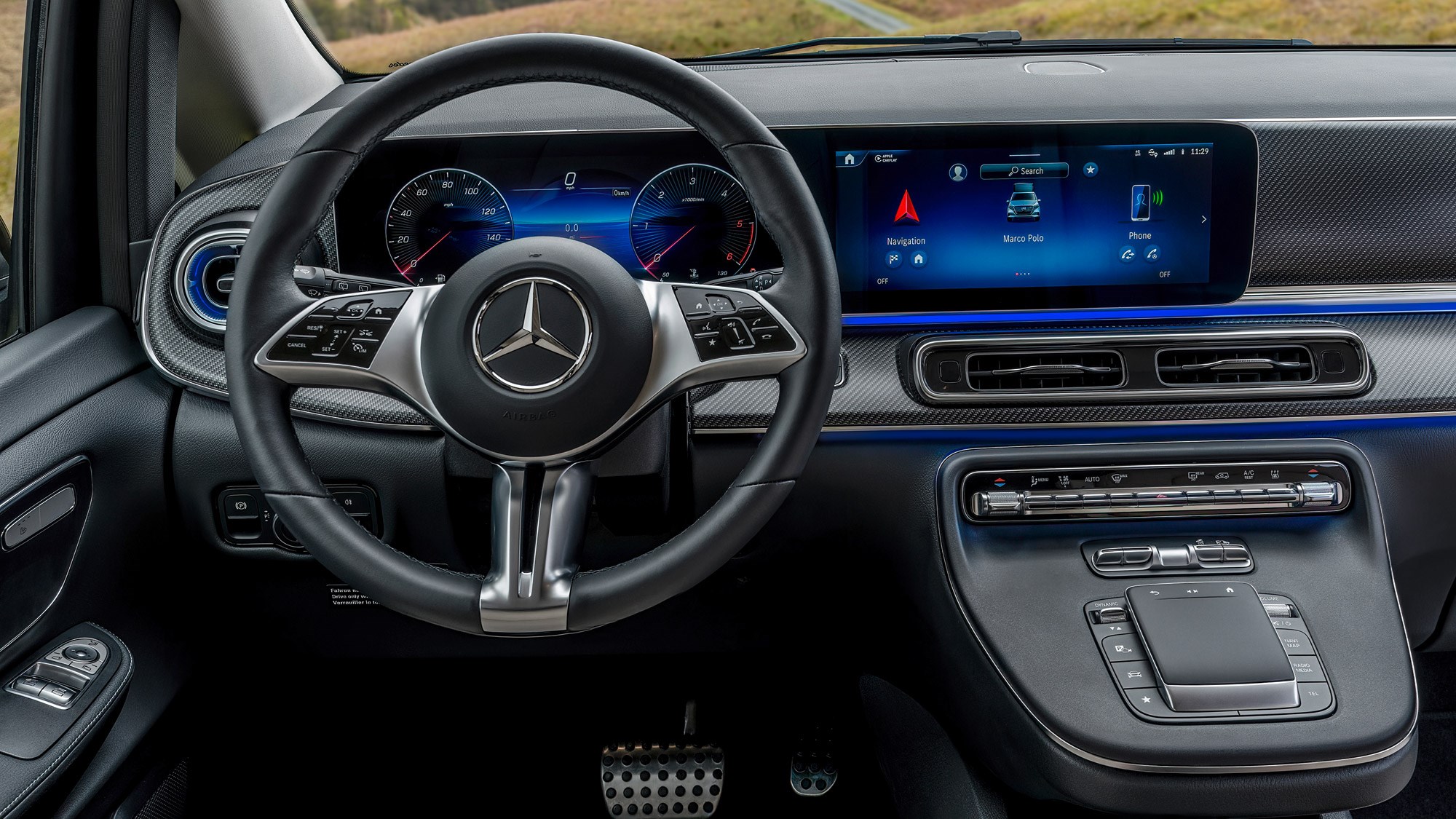
For as well as looking more modern, the infotainment element of the twin-screen arrangement now incorporates all the camping controls into the MBUX system, rather than relying on a separate unit. You can also take control of most of them via your phone.
The lounging, kitchen and sleeping areas of the cabin are largely as they were before. But since this means very high-quality cabinets, an electrically operated pop-up roof and electrically reclining rear seats that go fully horizontal to form part of the lower bed – not to mention the ‘Land Yacht’ flooring – there’s not much reason to complain. Although manually adjustable front seats in a near-£90k machine seems a bit tight, this is probably because they swivel.
The new self-levelling air-suspension gives the Marco Polo a party piece neither factory-backed campervan rival can yet match, too. We tested this in a couple of locations and found it worked exactly as advertised – adjusting the suspension height at each corner at the hold of a button in order to eliminate the pitch and tilt caused by bumpy camping ground locations. This means no driving around watching the dials to find the closest approximation to level, and ultimately a better night’s sleep.
What are the specs?
You can only buy the Marco Polo as a V300d in the UK now; the previously available V220d has been discontinued. This means a starting price of £88,420 (ouch), but you do get 233bhp and 369lb ft in exchange, mated to a nine-speed automatic transmission that has a very effective Sport setting.
That’s enough performance to drag 2631kg of luxury camper 0-62mph in a respectable 8.8sec – quick enough to make safe overtaking in the Scottish wilderness entirely possible, even when driving from the wrong side of the cab. The Marco Polo does come in right-hand-drive, it’s just that Scotland was chosen as the international launch venue, so all the vehicles on-hand were direct from Germany.
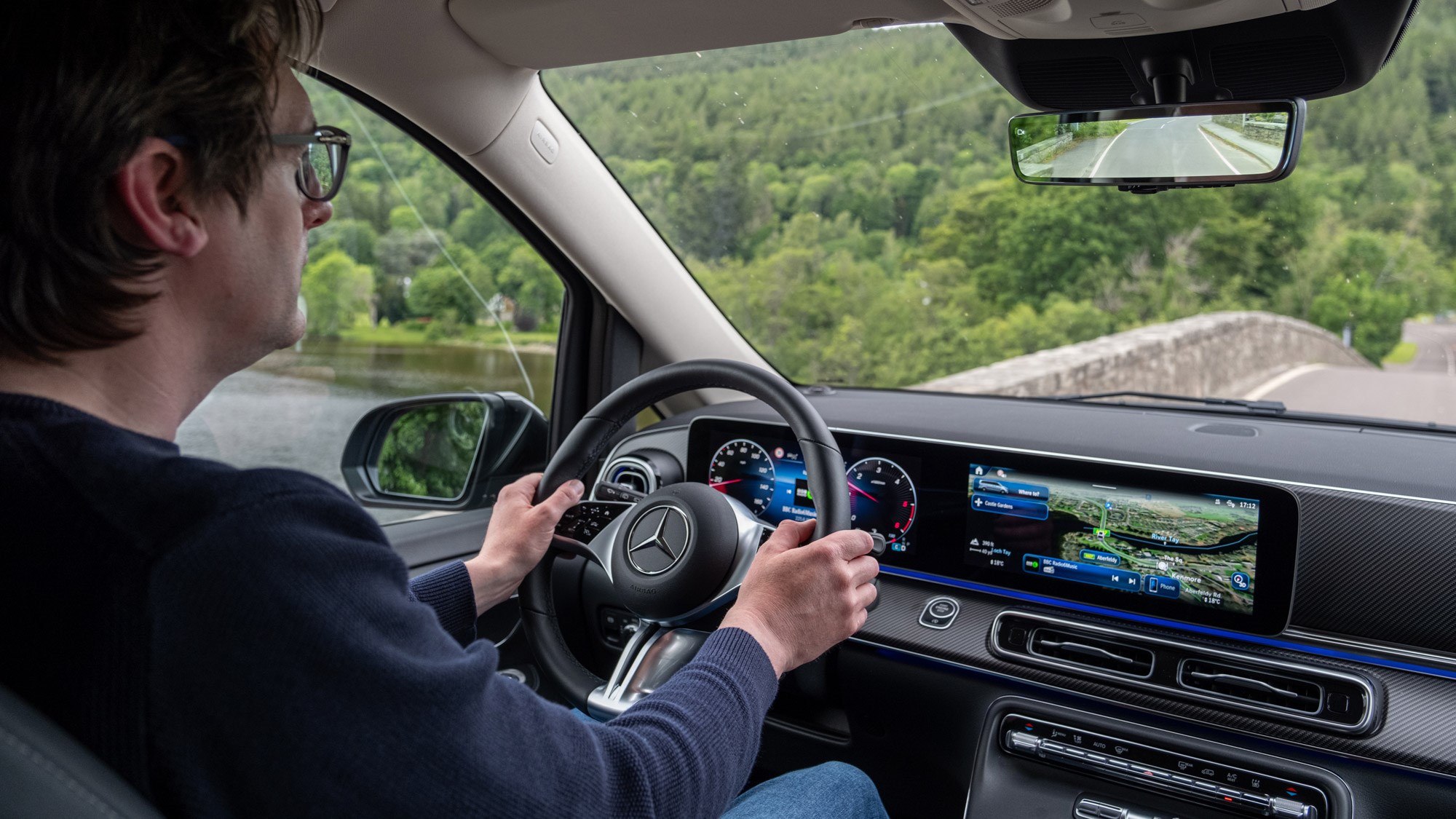
The only real issue with this is the presence of options UK buyers can’t have – such as the digital rear-view mirror. For some reason this is offered to V-Class MPV buyers here but not Marco Polo customers; a shame, because it works very well here and saves you having to peer behind through a space narrowed by cupboards.
Official WLTP fuel economy is 34.4-36.7mpg, with 216-202g/km CO2 emissions. I saw between 25 and 32mpg on the trip computer depending on how carried away I was getting with the scenery – but that was one-up with little luggage. Experience suggests anything above 30mpg will be good going fully loaded in mixed driving, with mid-30s possible on longer motorway schleps. Something the Marco Polo (and passengers) will make very light work of.
Vital camper stats include a twin-burner hob, single sink (beautifully finished) and 40-litre cool box with multiple settings – including the ability to go down to -18 degrees. Which will be handy for getting the frozen veg home from the supermarket in daily life duties. The Marco Polo can transport and sleep four, with the individual front seats able to rotate to face the rear cabin and create a lounge-like experience.
The sliding side door comes on the right side only – but because it’s easy to walk through to the front of the cabin it’s not difficult to deposit occupants safely on the pavement via the front passenger door. The cabin layout generally mirrors that of the Volkswagen California rather than the Transit Custom Nugget, and I’ll get into what that might mean for you in the interior section below.
What’s it like to drive?
Better than it needs to be, probably. With the proviso that my test vehicle was fitted with the air-suspension – distancing it further from those Vito van origins than the standard steel springs will surely manage – it coped well with a wide variety of road types and driving styles during this initial excursion.
A couple of things reveal the van beneath, so to speak. First is the driving position; you sit very high, looking down over the dashboard and steering wheel, which means great forward visibility but a rather bus-like wheel angle and a lot of glancing down away from the road to read the digital instruments. Second is the ride, which does rather thud into compressions, leading to a preliminary impression that the chassis is as leaden-footed as you’d reasonably expect 2.7-tonnes of mobile bedsit to be.
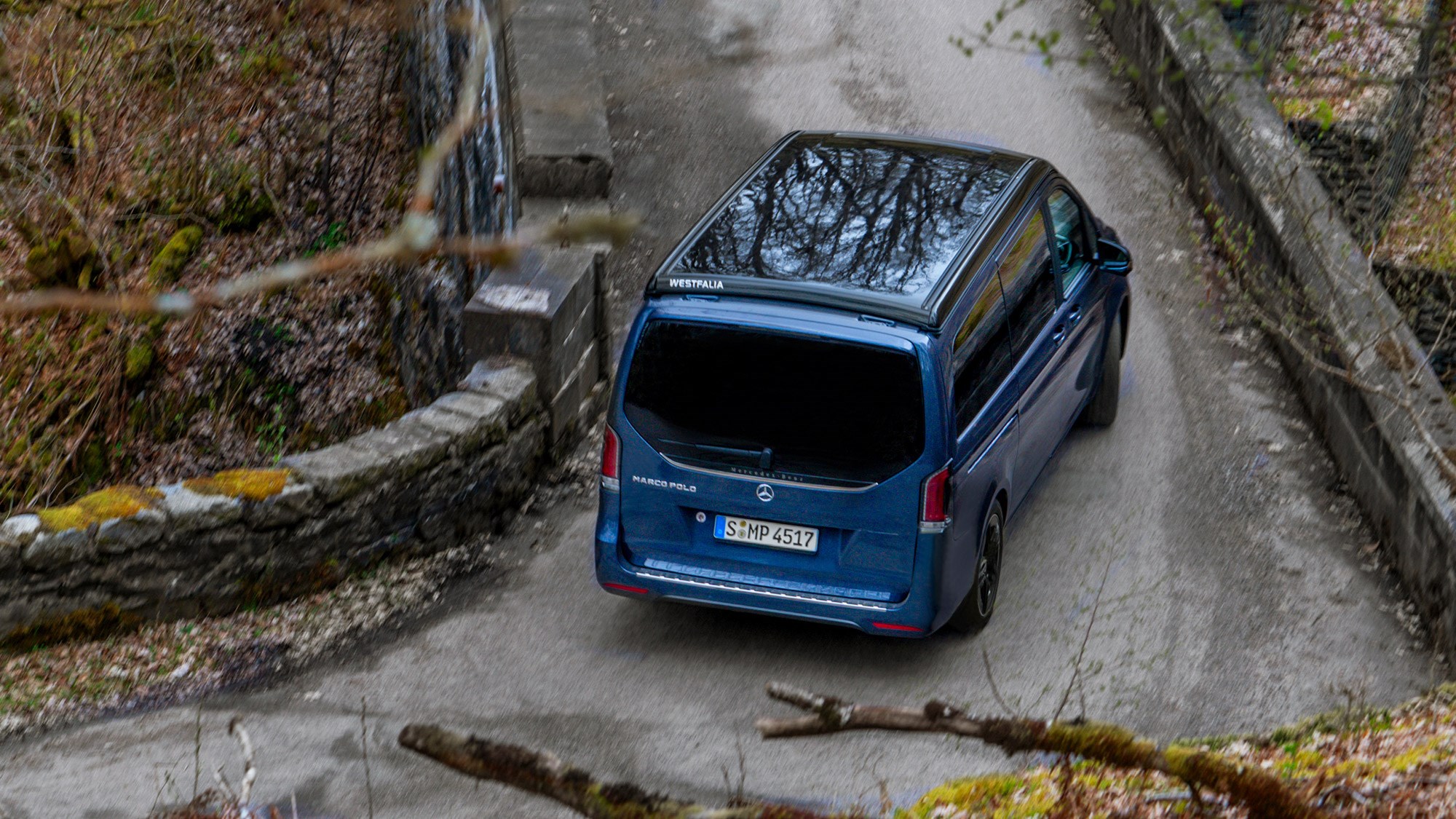
The steering is pretty faithful, though, helped by the rear-wheel drive powertrain, which neatly ducks all the scrabbliness that occasionally plagues front-wheel drive versions of the California (which is also offered with 4Motion all-wheel drive, something the Marco Polo cannot compete with in the UK, though 4Matic is available in Europe). And although there’s a sensation of top heaviness when cruising about in the Comfort driving mode, I found the more up-and-at-em eagerness of the Sport setting had me driving in a manner that seemed to negate this.
The Sport gearbox programming, for instance, is surprisingly on it – downshifting almost aggressively into corners and holding gears substantially longer as you accelerate. To the extent that I found myself rather enjoying the experience. It was quite refreshing to be driving something that doesn’t have too much supplementary interference with the steering and especially the brakes, which seem very finely tuned for purpose here.
It does come with adaptive cruise control, which will do some of the accelerating and braking for you, even on country roads with no traffic. Which means that with the active lane keeping also engaged I experimented with just steering for a while when the average speed cameras reared their little yellow heads. But pleasingly the lane keeping doesn’t seem to want to bother you when the adaptive cruise is disengaged.
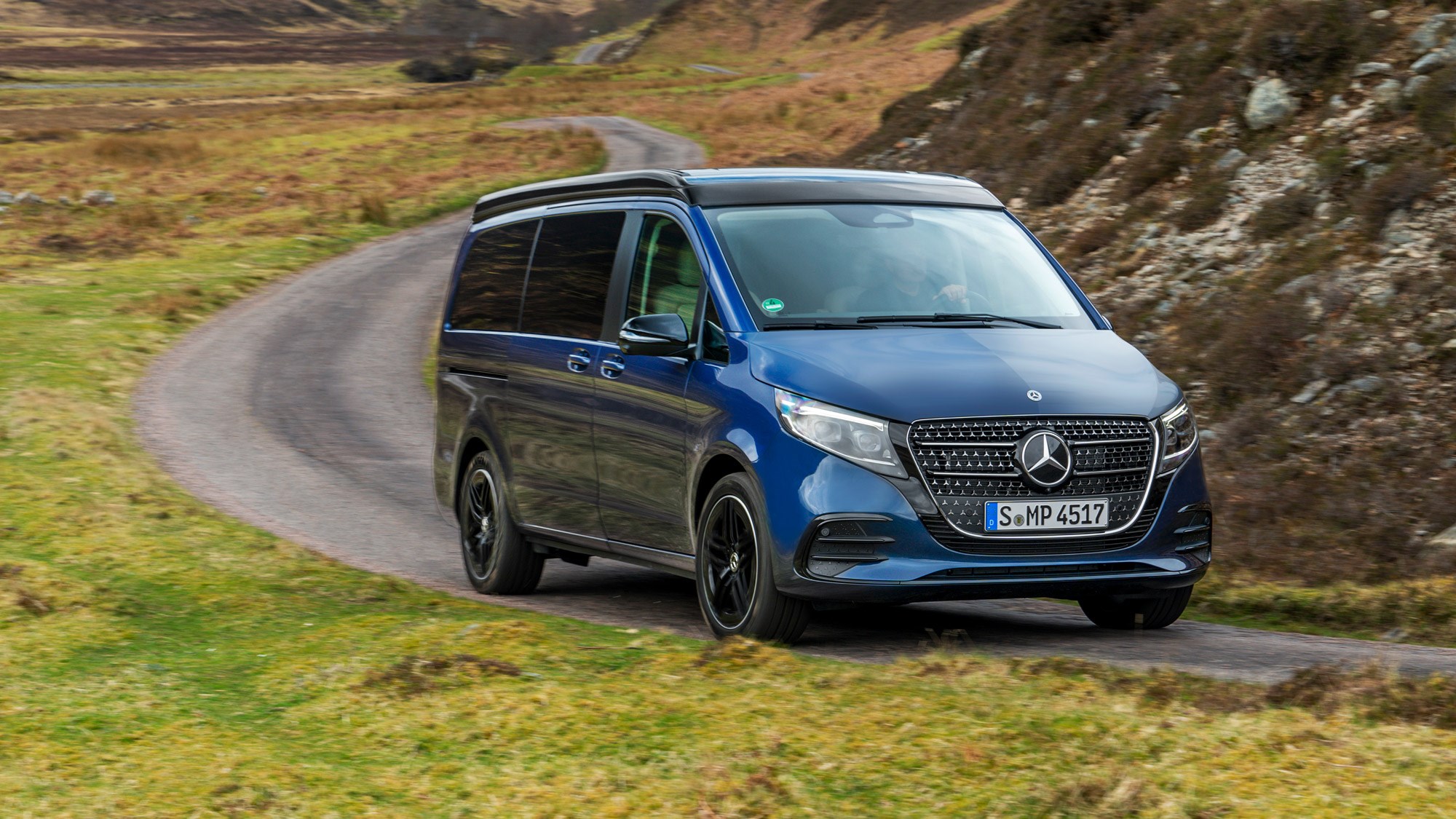
There’s plenty of power and torque, too, and I have no complaints about the refinement – for a large box there’s little resonance and minimal flex, and not even much wind noise. Magnetic crockery and fabric-bagged cutlery helps keep the usual camper racket down, though I could still hear pots and pans sliding about. Probably my fault, that.
Decidedly less impressive were the two occasions in two days where the PreSafe and autonomous emergency braking system suffered false-positive panics – once when a motorcycle was pulling up to an adjoining junction and then later apparent alarm at a tree branch over the road. As well as snapping the seat belt tight and firing the brakes, this certainly gave the cars behind an unwarranted wake-up call.
What about the interior?
Starting at the front, the twin 12.3-inch screens look as gloriously – or, depending on your perspective, predictably – modern as you’d expect. To my eyes they instantly elevate the Marco Polo’s cockpit, but I know not everybody likes them. The MBUX infotainment system is as good as ever, though, with first-class voice control and augmented navigation. Shame there’s no head-up display.
Moving back to the living area, quality is very high – and while you don’t get a table and chairs hidden in the doors like you do in a California (here they’re an optional extra that lives in a bin beneath the boot divider – you do get an opening tailgate window. Which may prove very handy in tight car parks.
The layout is the same as the Volkswagen, too, meaning a kitchen area at the side in the middle and an overhead sleep area accessed by climbing the front seats. This is the comfier place to snooze if you can make it up there, thanks to plastic coil springs and a thin but proper memory foam mattress. The interior ceiling can be raised for head room when you’re not sleeping up top, but this is a slightly awkward and heavy affair.
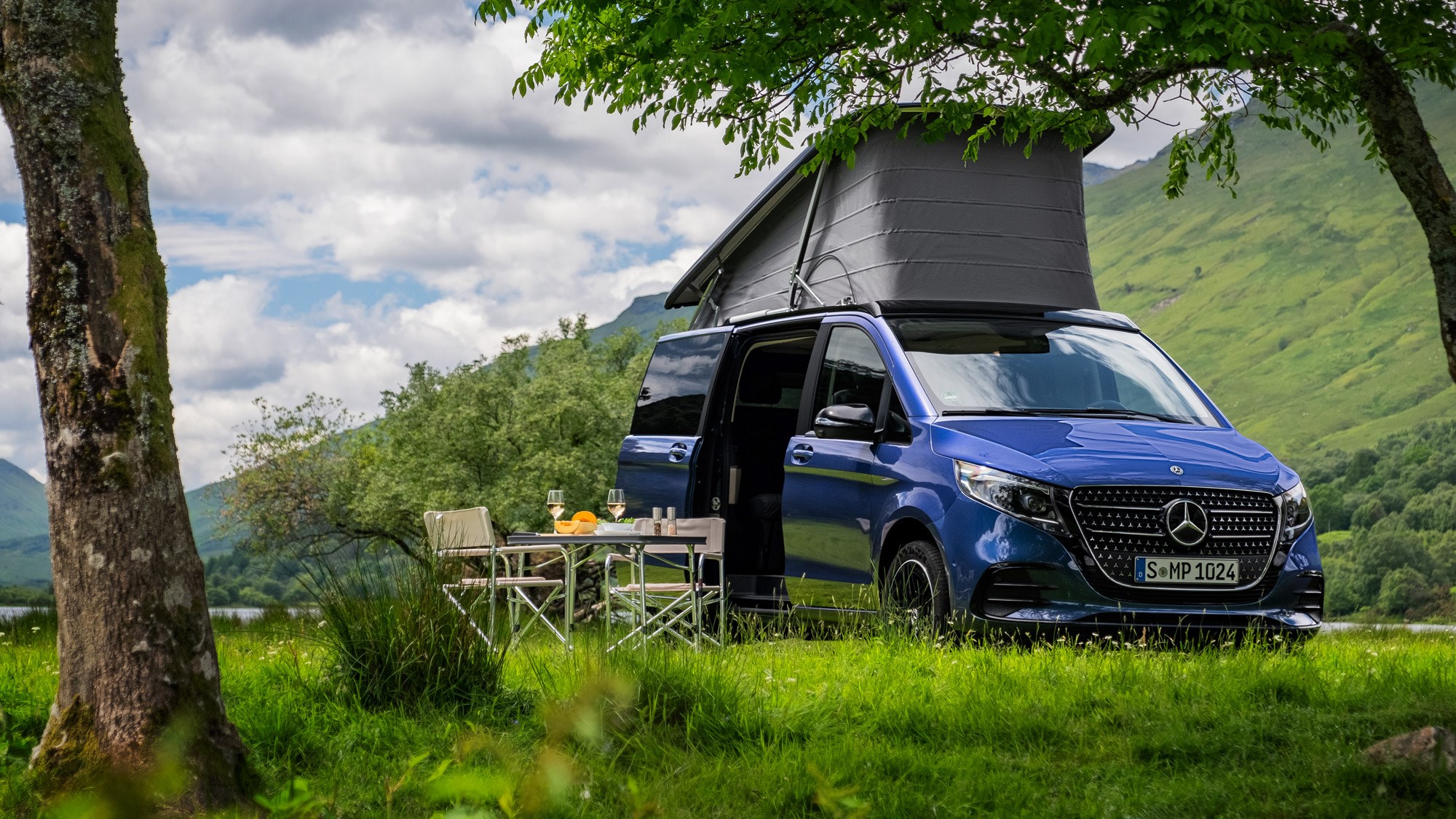
The Transit Custom Nugget approaches this differently, with a kitchen at the back and the top sleeping area accessed via a ladder. This is easier, but is likely to be less pleasant when it’s raining. In the Marco Polo – and the California – you can cook, dine and then go to sleep without having to step outside into the weather.
There are blinds built into most to the side windows – I found the one of the tailgate tricky to hook up, but once you have the knack of it you’ll be fine; it’s easier to do it when the tailgate is open above you – plus magnetic ones for the front doors and a large panel for the windscreen held in place by the sun visors. Bit of a faff, but ok.
There’s plenty of cupboard storage for a few days away, and there are neat lighting solutions and power sockets in convenient places. Just note that the boot area is divided by the rear lower bed panel, so it isn’t as spacious back there as you might guess. Especially when the lower bin is filled with the optional outside camping table and two chairs. But the rear bench slides forward, so you should be able to get enough luggage for four on board.
The gas bottle and an outdoor shower are located at the left rear corner of the van. The shower is probably best left to muddy dogs and welly boots, but is a useful feature, nonetheless.
Before you buy (trims and rivals)
The 2024 Marco Polo only comes in one specification, Premium Plus, though an AMG Line package of extras can be added to this. Standard equipment is very generous, with the AMG Line pack focused entirely on styling changes. Beyond this there are just seven factory options for UK buyers, though you can pick from 10 paint colours.
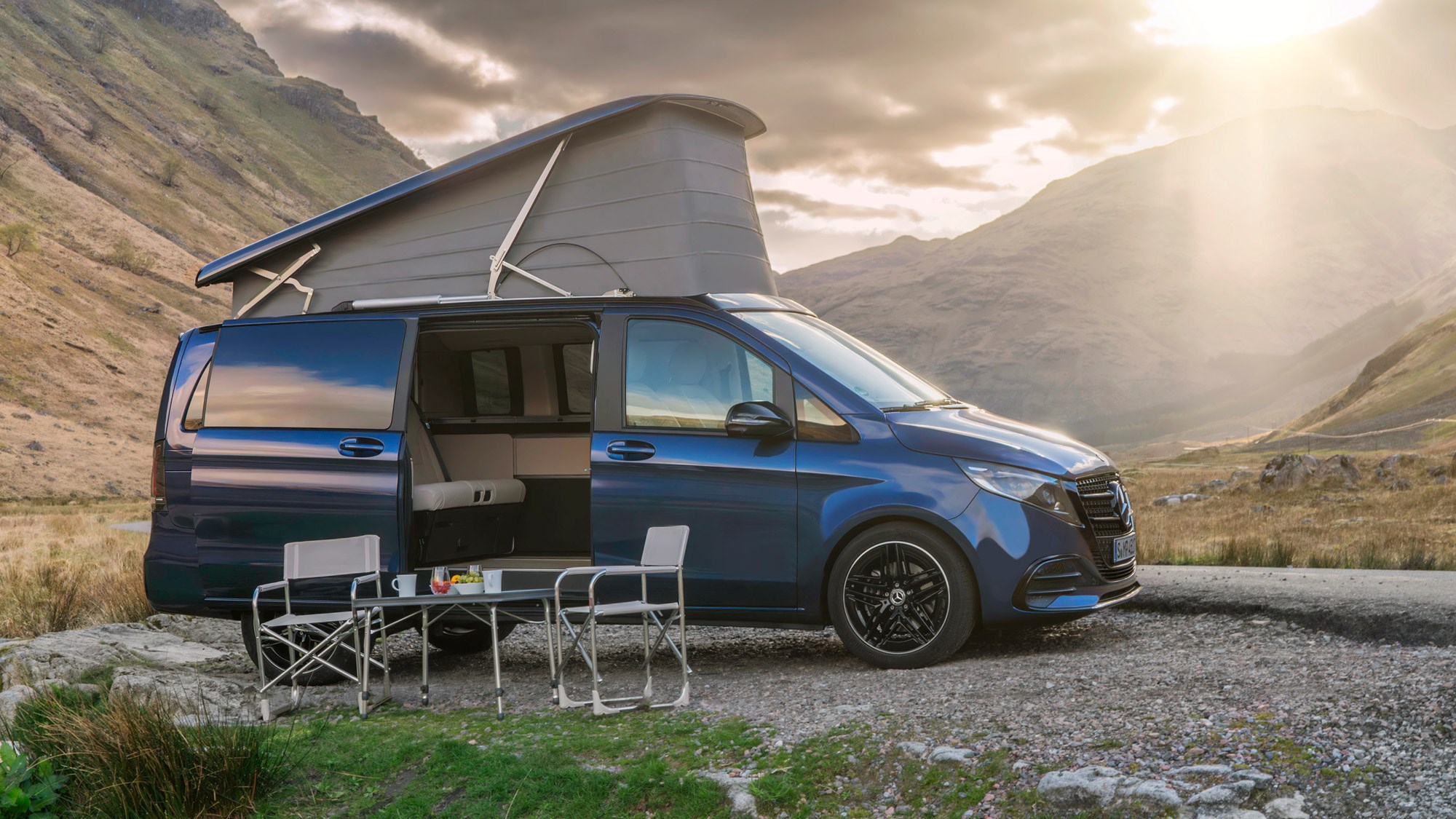
We’ve covered the major rivals above. The VW California remains the only fully factory-designed and engineered camper, with the Marco Polo and Transit Custom Nugget leaning on campervan specialists Westfalia for some of their components. This makes little difference in operation, aside from some of the tricksier storage solutions VW is able to deploy.
The main buying decisions therefore come down to cost, image and layout. Some will prefer the different interior design of the Ford, others will only want a California. The Marco Polo is by far the most expensive. But if you can afford it, and the extra £3,100 for the air suspension, you’re getting a home-on-wheels-away-from-home experience that lives up to the billing.
Verdict
If you can afford it, you probably won’t regret it. The Marco Polo offers almost the same mobile vacationing capability as the VW California, but the quality is a little higher, the dynamics a little better and the self-levelling air suspension certainly slicker. Frankly, you’ll be happy with any of the big players in this sector, but the three-pointed star is still the choice I’d aspire to here.